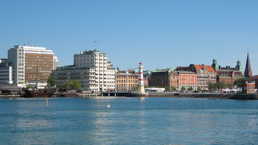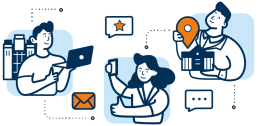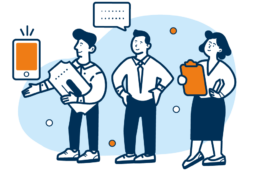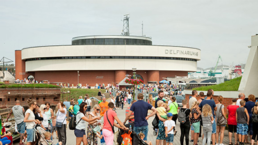BalticMuseums:Love IT! Team:
9 partners and 7 associated partners.

Malmö Stad

Natur Bornholm

University of Szczecin

Hochschule Stralsund

Wirtschaftsakademie Nord

Netcamp
BYOD Tours
(Bring Your Own Device)
The project team has set up multilingual tours that will run on the visitors’ own devices (e.g. smartphones) which they bring to the attractions.
Addressing the trend of gamification, project team have used game elements to make the visitors’ experience more involving, and extend the single visit into long-term relationships. Working with a user-centric design process of the new products, the team involved the target group into the development. IT enthusiasts were invited to special programming events (so-called ‘hackathon’) that took place directly in the touristic attractions. The creative ideas generated during these events were further developed into fully fledged gamified apps.

KNOWLEDGE

The exchange of experiences amongst the partners involving visitors and users to create IT supported touristic offers forms the basis of the project.
The team have workedwith approaches of User Experience and Generic Learning Outcomes and developed as well as shared knowledge regarding digital strategies for attractions, insights in working with digital natives, storytelling or understanding concepts of motivation and loyalty. Experiences made during the project e.g. in setting up hackathons were captured. The gained knowledge of the partners is available on an online platform, for the benefit of other destinations and attractions.
KNOWLEDGE BASE
e-Guide, APPs, BYOD, UX, GLO, Hackathons - find out about how Information Technology can add value in touristic attractions!
The BalticMuseums team gathers its experiences and insights during the project BalticMuseums: LoveIT! - Join our learning journey!
BRAND & NETWORK
The application of IT-enabled services in museums and attractions is nowadays a quality attribute.
The major challenge is the rapid development of both technology and consumer expectations. To turn this challenge into an opportunity, the project team has developed inspiring, though practical solutions within the core team, however, as well for the benefit of other attractions outside of the project. To make the new gamified products better recognizable and marketable, the project team elaborated the emused.eu brand. The project consortium encourages other attractions to make use of the tools, the findings and the brand developed as part of ‘BalticMuseums: Love IT!’ – aiming at forming a sustainable cross-border network of tourist attractions and destinations for a continuous exchange on IT-enabled services and digital strategies. Attractions love IT and visitors love it!

OUR HISTORY
The BalticMuseums story started in the year 2009. A diploma thesis at Stralsund University of Applied Sciences in cooperation with the German Oceanographic Museum on electronic guides in museums gave the impulse for developing the BalticMuseums consortium.
The major challenge is the rapid development of both technology and consumer expectations. To turn this challenge into an opportunity, the project team has developed inspiring, though practical solutions within the core team, however, as well for the benefit of other attractions outside of the project. To make the new gamified products better recognizable and marketable, the project team elaborated the emused.eu brand. The project consortium encourages other attractions to make use of the tools, the findings and the brand developed as part of ‘BalticMuseums: Love IT!’ – aiming at forming a sustainable cross-border network of tourist attractions and destinations for a continuous exchange on IT-enabled services and digital strategies. Attractions love IT and visitors love it!

University of Szczecin

Hochschule Stralsund

Gdynia Aquarium

Lithuanian Sea Museum

Natur Bornholm

Netcamp

Wirtschaftsakademie Nord

Four projects, many discoveries and tools
In the course of the over 10-year cooperation, funds of around 3.9 million euros were raised for the consortium, all partly financed by the European Regional Development Fund within the Interreg South Baltic Programme,to which the teamowesgreat gratitude.
The first project
Baltic Museum 2.0 (2009-2012, Lead Partner: Stralsund University of Applied Sciences, Germany) – joined six institutions from four countries. Its major purpose was establishing a common web portal: amodern site that would enable tourists from Europe to discover affiliated institutions. An important element of the process was also turning attention to the youngest. A children’s zone with games, colouringpages and a knowledge area became an integral section of the portal. Joint investigations on implementing online ticketing services and options for electronic visitor guidance systems laid the ground for the second project, BalticMuseums2.0 PLUS.
The second project
BalticMuseums2.0 PLUS (2010-2015, Lead Partner: Stralsund University of Applied Sciences, Germany) – focused on implementing multimedia visitor guides. Ten additional associated partners joined the consortium. At that time, electronic visitor guides, so-called e-guides, were just beginning to get popular and the museums faced the common challenge of how the new opportunities could be used sustainably for their visitors. Jointly developing both the tools and the services for such e-guides allowed a more involving visitor experience in various languages at the partner museums. Sharing multimedia content was one of the elements of mutual support of the partners, backed by a common platform for sharing contents -Resource Space, which allows for free sharing of materials, photos, films for useby the partner institutions.
The third project
BalticMuseumsClusters (2015, Lead Partner: Stralsund University of Applied Sciences, Germany) – was a so-called seed money project of just a few partners, looking into the opportunities of future cooperation clusters for sustainable tourism using smart tools for cooperation and branding and thus laying the ground for future projects, such as the fourth project: BalticMuseums: Love IT!.
The fourth project
BalticMuseums: Love IT! (2017-2020, Lead Partner: University of Szczecin) – was focused on enabling tourist attractions to offer gamified eGuide apps under a common brand. University of Szczecin leaded the consortium for inventing applications for smartphone users, following the trends of „Bring your own device” and gamification. The products of the project provide touristic attractions both with a tried and tested software and a brand to set up their own to e-guide apps with mini-games. Visitors can thus playfully learn in museums with their own smartphones. It also helps museums provide extended digital services, both during the actual visit, but also from home. The latter proved especially valid in a crisis situation, such as Covid-19 crisis in 2020. The project products will be managed by a cross-border network of tourist facilities, that use this brand and exchange information on IT developments for tourist attractions on a permanent basis: emused.eu



